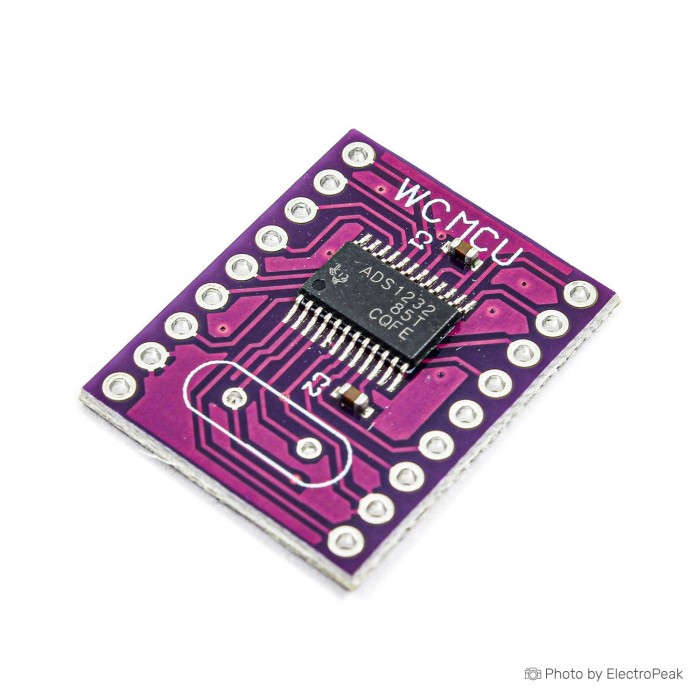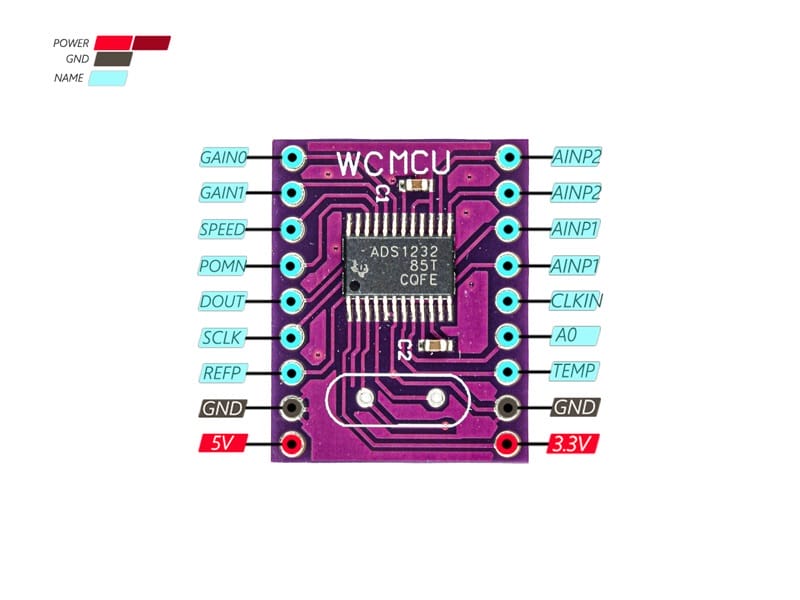Yes, the ADS1232 module can be interfaced with a Raspberry Pi using its two-wire serial interface (I2C).
ADS1232 24-Bit ADC Analog Digital Converter Module
Volume discounts:
- +25 4 % $3.8000
- +100 6 % $3.7200
- +300 8 % $3.6500
- +500 10 % $3.5700
- +1000 11 % $3.5000
 SP3485 RS485 to TTL Module
Previous
SP3485 RS485 to TTL Module
Previous

The ADS1232 24-Bit ADC Analog Digital Converter Module stands as a cutting-edge solution in the realm of analog-to-digital conversion, offering precision and versatility for a wide range of applications. Designed to meet the demands of both electronics enthusiasts and professionals, this module has established itself as a go-to choice for projects that require high-accuracy measurements and reliable signal conversion.
ADS1232 24-Bit ADC Analog Digital Converter Module emerges as a powerful and versatile tool, delivering the precision required for critical applications.
Specifications of ADS1232 24-Bit ADC Analog Digital Converter Module
- Resolution: Up to 23.5 effective bits
- PGA gain: 1, 2, 64 or 128
- RMS noise: 17nV at 10SPS (PGA = 128), 44nV at 80SPS ( PGA = 128), 19.2-bit noise-free resolution at gain = 64
- Flexible clocking: On-board oscillator with low drift (± 3%) Optional external crystal
- Data rates: 10SPS or 80SPS
- Inputs: Two-channel differential input with built-in temperature sensor (ADS1232)
- Output: Two-wire serial interface
- Supply voltage range:7 V to 5.3 V
- Temperature range: “40°C to +105°C
Key features of ADS1232 24-Bit ADC Analog Digital Converter Module
- High Precision 24-Bit Resolution: The ADS1232 module offers an impressive 24-bit resolution, providing an exceptionally high level of precision in converting analog signals to digital data. This enables accurate and detailed measurements, making it suitable for applications where precision is critical.
- Low-Noise Amplifier: Incorporating a low-noise amplifier, the module ensures minimal interference and enhances the signal-to-noise ratio. This feature is particularly valuable in scenarios where the input signals are weak or in environments with high levels of electrical noise.
- High Gain Settings: The ADS1232 allows for adjustable gain settings, providing flexibility in capturing a wide range of signal amplitudes. The onboard low-noise PGA has selectable gain of 1, 2, 64 or 128 and supports a full-scale differential input of ± 2.5 V, ± 1.25 V, ± 39 mV or ± 19.5 mV.
- Versatility in Input Signal Handling: Designed to cater to various applications, the module supports a diverse range of input signals. This includes compatibility with temperature sensors, strain gauges, and other analog devices, making it suitable for a broad spectrum of projects.
- Serial Interface for Easy Integration: The inclusion of a serial interface simplifies communication with microcontrollers and other digital devices. This feature enhances the module's usability in embedded systems and Internet of Things (IoT) projects, allowing for efficient data transfer and processing.
- Compact and Robust Design: The ADS1232 features a compact and robust design, making it easy to integrate into different projects. Its small form factor ensures flexibility in placement and usage, accommodating a variety of setups and environments.
- Wide Operating Voltage Range: The module operates within a wide voltage range (typically 2.7V to 5.3V), providing compatibility with different power sources. This makes it adaptable to various electronic systems and power supply configurations.
- Internal Oscillator for Clock Generation: With an internal oscillator, the module generates the clock signal required for precise analog-to-digital conversion. This eliminates the need for an external clock source, simplifying the setup and reducing the overall component count.
ADS1232 24-Bit ADC Analog Digital Converter Module Pinout
The ADS1232 ADC Module has 10 pins:
- 3V: Module power supply “ 3.3V
- 5V: Module power supply “ 5V
- GND: Ground
- REFP: Reference Voltage
- SCLK: Source Clock for Synchronization
- DOUT: Data Transmit Line
- POMN: Module Power Control
- SPEED: Data Transmit Speed
- GAIN1: Gain Selection
- GAIN0: Gain Selection
- TEMP: Temperature Sensor Selection
- A0: First Analog Input
- CLKIN: External Clock Input
- AINP1: Wheatstone Bridge Input 1
- AINP2: Wheatstone Bridge Input 2
Using Tips of ADS1232 24-Bit ADC Analog Digital Converter Module
- Calibration: Regular calibration is essential to maintain accurate readings over time. Implement a calibration routine based on the specific requirements of your application. This is particularly crucial in applications where precision is paramount.
- ·Signal Conditioning: Take advantage of the low-noise amplifier and high gain settings by implementing effective signal conditioning techniques. Ensure that the input signals are within the specified range and consider filtering out any unwanted noise or interference before feeding them into the module.
- Power Supply Stability: Maintain a stable power supply for the ADS1232 module. Fluctuations in power can impact the accuracy of the ADC readings. Use regulated power supplies and consider incorporating filtering components to ensure a stable and clean power source.
- Grounding: Pay careful attention to grounding. Proper grounding is crucial for minimizing noise and interference. Ensure that the module's ground is connected securely and consider implementing grounding techniques such as star grounding to prevent ground loops.
- Temperature Considerations: Be mindful of the operating temperature range of the ADS1232. Operating within the specified temperature limits ensures reliable and accurate performance.
- Input Signal Integrity: Keep the integrity of the input signals in mind. Shield sensitive input lines from external interference, and avoid routing them near sources of electromagnetic interference (EMI).
FAQs
Can the ADS1232 module be interfaced with a Raspberry Pi for data acquisition?
Can I use the ADS1232 module in low-power applications?
Yes, the ADS1232 module can be used in low-power applications. Its low-power consumption makes it suitable for battery-operated devices and applications where power efficiency is a consideration.
How do I troubleshoot erratic readings from the ADS1232?
If you encounter erratic readings, check the connections, ensure proper grounding, and verify that the input signals are within the specified range. Calibration may also help correct any offset or gain errors. Review the datasheet for troubleshooting tips and consult online forums for community support.
Can the ADS1232 be used with sensors other than strain gauges and temperature sensors?
Yes, the ADS1232 is versatile and can be used with various sensors, including load cells, pressure sensors, and other analog devices. Ensure that the sensor's output is within the input range supported by the ADS1232.
What is the role of the internal oscillator in the ADS1232 module?
The internal oscillator generates the clock signal required for the analog-to-digital conversion process. It eliminates the need for an external clock source, simplifying the setup and reducing the overall component count.






Please complete your information below to login.
Sign In
Create New Account